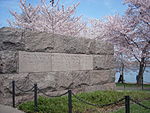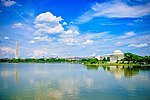Air Florida Flight 90

Air Florida Flight 90 was a scheduled U.S. domestic passenger flight operated by Air Florida from Washington National Airport (now Ronald Reagan Washington National Airport) to Fort Lauderdale–Hollywood International Airport, with an intermediate stopover at Tampa International Airport. On January 13, 1982, the Boeing 737-222 registered as N62AF crashed into the 14th Street Bridge over the Potomac River.Striking the bridge, which carries Interstate 395 between Washington, DC, and Arlington County, Virginia, it hit seven occupied vehicles and destroyed 97 feet (30 m) of guard rail: 5 before plunging through the ice into the Potomac River. The aircraft was carrying 74 passengers and five crew members. Only four passengers and one crew member (a flight attendant) were rescued from the crash and survived. Another passenger, Arland D. Williams, Jr., assisted in the rescue of the survivors, but drowned before he could be rescued. Four motorists on the bridge were killed. The survivors were rescued from the icy river by civilians and professionals. President Ronald Reagan commended these acts during his State of the Union speech a few days later. The National Transportation Safety Board (NTSB) determined that the cause of the accident was pilot error. The pilots failed to switch on the engines' internal ice protection systems, used reverse thrust in a snowstorm prior to takeoff, tried to use the jet exhaust of a plane in front of them to melt their ice, and failed to abandon the takeoff even after detecting a power problem while taxiing and having ice and snow build up on the wings.
Excerpt from the Wikipedia article Air Florida Flight 90 (License: CC BY-SA 3.0, Authors, Images).Air Florida Flight 90
395 Express Lane, Washington
Geographical coordinates (GPS) Address Nearby Places Show on map
Geographical coordinates (GPS)
| Latitude | Longitude |
|---|---|
| N 38.876388888889 ° | E -77.0425 ° |
Address
George Mason Memorial Bridge
395 Express Lane
20228 Washington
District of Columbia, United States
Open on Google Maps










